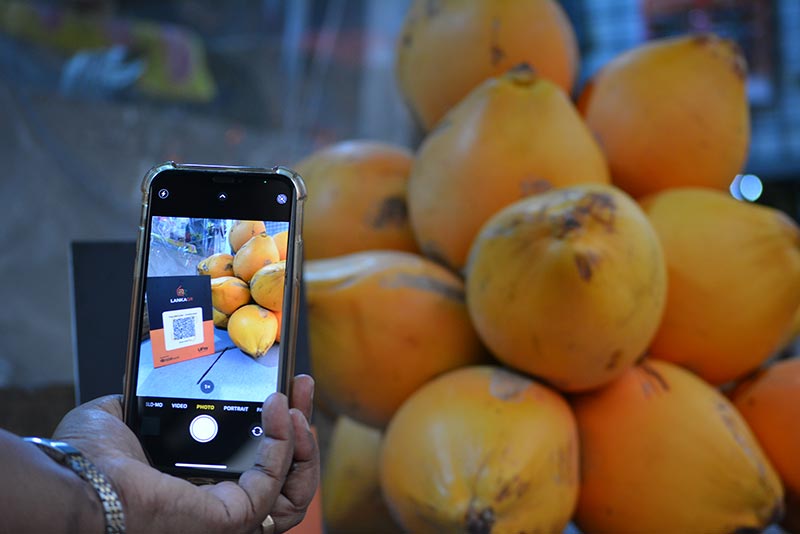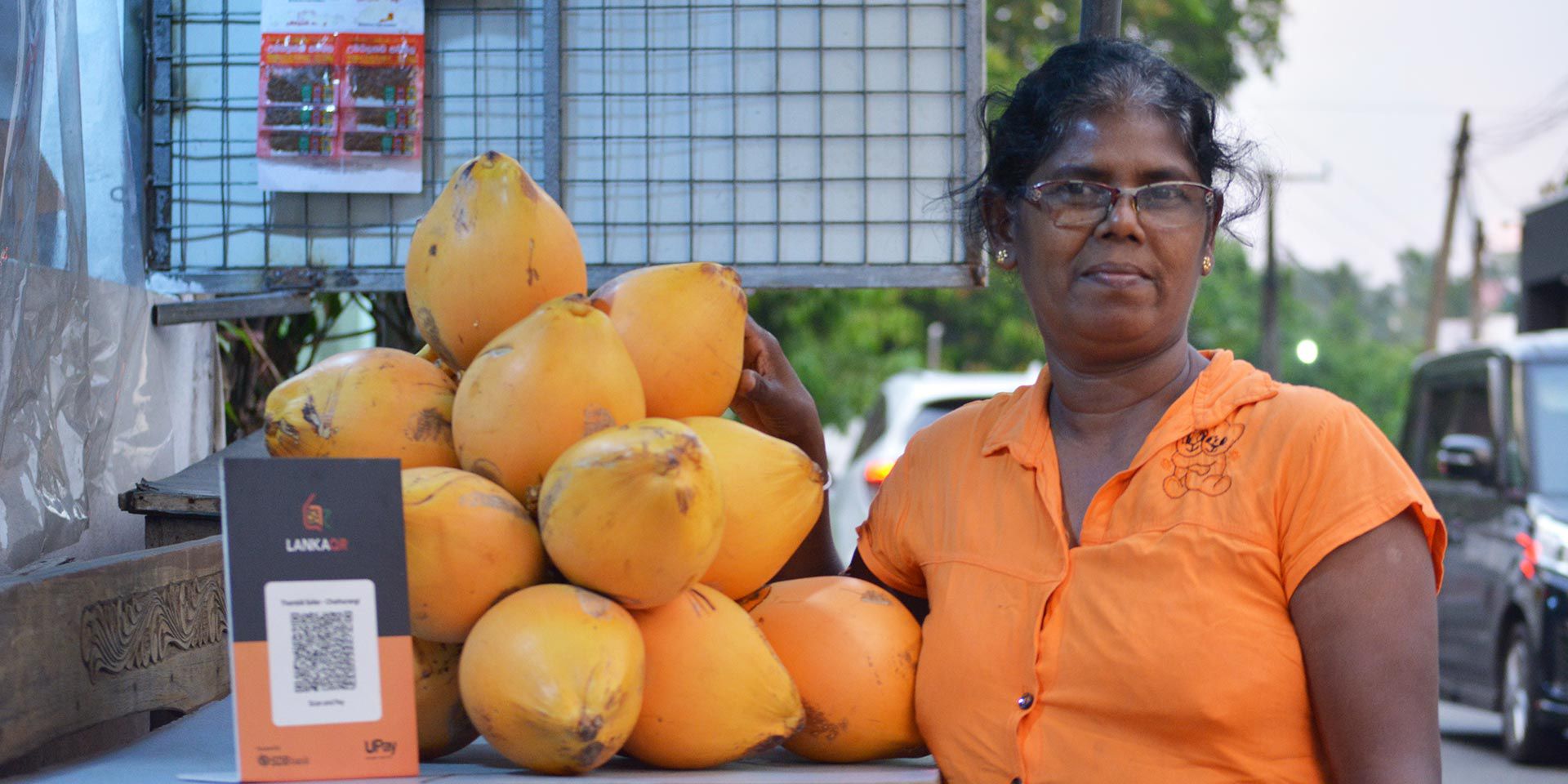- Sri Lanka has launched a push to help small businesses “go digital” in their banking.
- The initiative, supported by IFC, is helping business owners be more productive.
- Financial inclusion can help close the gender divide, giving a boost to women entrepreneurs.
By Savani Jayasooriya
The refreshing taste of thambili, otherwise known as king coconut, is a preferred beverage for many Sri Lankans. Roadside stalls laden with thambili, like one owned by Siriyawathi Perera in Maharagama, a half an hour drive from Sri Lanka’s commercial capital Colombo, are the ideal place to quench your thirst after a hectic day’s work.
The demand for thambili is high—and the customers are usually in a hurry. “It’s always a quick sip for most of those who stop by, which means that I have to hurry with the ‘märu salli,’” said Perera, referring to the local expression for the money change left over after a transaction. The constant demand for quick service and the haste to find the correct change for a thambili, which costs around $60 cents, always posed a challenge for this roadside shop owner.
Perera, the sole breadwinner for her family, often felt she had only a few options when it came to managing her finances. Like many of her peers, she felt comfortable relying on informal sources of income, with little or no knowledge of formal financial services.
“I didn’t know anything about banking before,” said Perera. Just last year, she found herself as the center of an unexpected offer when a couple of new customers walked into her roadside shop for a quick sip of thambili. Turns out these customers, who worked at a bank, not only quenched their thirst, but also ended up convincing Perera to become a customer of their bank.
The move to accelerate digital financial inclusion—bringing even the smallest of transactions into the formal banking system—is one of the key outcomes of Sri Lanka’s first National Financial Inclusion Strategy (NFIS).
The NFIS is a multi-stakeholder effort led by the Central Bank of Sri Lanka, with technical and financial assistance from IFC, under the IFC-DFAT Women in Work program.
A survey sheds light on women and digital banking
The basis of the strategy was the result of a national survey that assessed the level of financial inclusion in the country. The findings of the survey, which took a gender-sensitive approach, revealed that 62 percent of women were aware of making financial transactions through mobile phones. However, a little less than one-third claimed they were comfortable making mobile transactions.
The survey also highlighted a similar trend in payment cards. While ownership of credit and debit cards is slowly increasing, Sri Lanka essentially remains a cash economy, with only 38 percent of the population at ease using debit cards. From a gender perspective, men were more comfortable using debit cards—41 percent of men compared to 35 percent of women, according to the survey.
One thing was clear: while Sri Lanka’s digital financial service infrastructure has kept pace with international developments, overall uptake was low, especially among women.
In 2018 when IFC partnered with Sri Lanka’s central bank to develop the NFIS, digital finance was highlighted as a key pillar of the strategy.
Consequently, the concept of LANKAQR—a national Quick Response (QR) code—got accelerated. This was adopted by Sri Lankan financial institutions to facilitate fast, secure and low-cost digital payments to any merchant with a special focus on small and medium enterprises. It enables customers to pay merchants directly from their bank accounts using a LANKAQR compliant mobile payment app.

The LANKAQR code, a national Quick Response (QR) code, displayed at the store facilitating fast, secure and low-cost digital payments.
Just a few days before the COVID-19 pandemic reached the shores of Sri Lanka, the Central Bank announced that 2020 would be considered the “Year of Digital Transactions,” as part of the overall financial inclusion policy.
“We see financial inclusion as more of a cross cutting issue and consider it as a core pillar in each of our NFIS objectives,” said Mr. D. Kumaratunge, Director of Payments and Settlements Department at the Central Bank. “Even with our Digital 2020 initiatives, we kept financial inclusion in mind as we explored different digital payment initiatives that targeted the economically disadvantaged people.”
Globally, financial inclusion is considered a building block for both poverty reduction and opportunities for economic growth. Having a formal banking account facilitates day-to-day living, and helps families and businesses plan for everything from long-term goals to unexpected emergencies. As account holders, people are more likely to use other financial services, such as savings, credit and insurance, start and expand businesses, invest in education or health, manage risk, and weather financial shocks, all of which can improve their quality of life.
Since 2011, 1.2 billion adults worldwide have gotten access to an account. However, close to one-third of adults—1.7 billion—are still “unbanked.”
Part of Sri Lanka’s initiative was the launch of “Cash Wade”—a trilingual nationwide campaign that aimed to address the challenges consumers and businesses face when using cash, such as the hassle of the “märu salli,” long waits and risk of being robbed. The campaign by the Central Bank of Sri Lanka, IFC and LankaClear, the national payment infrastructure provider, aimed to encourage as many customers to use digital payment methods like mobile applications, the LANKAQR code, along with credit and debit cards. Steps were also taken to train financial sector employees to be digitally savvy in order to be effective agents of the transformation process.
Among the banks and financial institutions that joined the effort were IFC clients including SDB Bank, Nations Trust Bank, Sampath Bank and Commercial Bank of Ceylon.
All of these efforts became a beacon of hope for merchants like Perera in the bleakest of times.
Now if you visit Perera for a quick sip of thambili, it’s a matter of just holding your mobile device to scan the QR codes posted in her store. “With the QR codes in place, I don’t have to worry about ‘märu salli’ anymore.” She added, “With the coronavirus, customers were very happy to use the QR.”
With COVID-19 spreading across the country, the drive towards “digital” uptake was intensified. Many customers who did not engage in digital financing before became more aware and were proactively introduced to digital payments methods by the financial institutions.
According to the central bank, the growth of QR payments in Sri Lanka increased by around 400 percent from a base of almost zero in January 2020.
Digital payments are not just for roadside shops
In parallel, the Cash Wade campaign was deployed to support the health sector as part of the COVID response by promoting contactless payments. In collaboration with Sri Lanka Pharmacy Owners’ Association, the ‘JustPay’ enabled payments app was promoted within the network of over 1,800 pharmacies to encourage the use of digital payments during the crisis. JustPay is the payment infrastructure introduced by LankaClear to support small value payments.
According to the latest data, the overall usage of the JustPay enabled apps for small value transactions indicates an upward trend, doubling in both value and volume.
COVID-19 disrupted everyday life in a way no one expected. However, it also became a tipping point particularly for small businesses, like Perera’s, to embrace the transformative potential of digital financing, helping to increase financial inclusion.
As for Perera, she hopes that more people would embrace fintech solutions. “It’s making our lives easier, and more importantly, safer,” she said.
Published in March 2021
